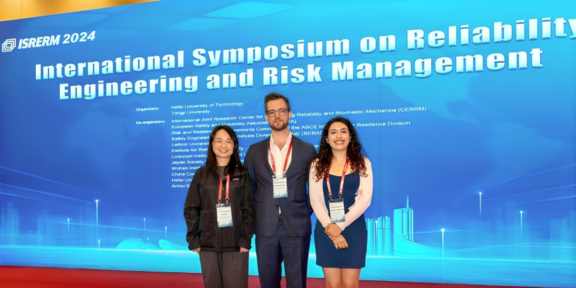CRE’s contributions to ISRERM 2024 conference

From October 18-21, 2024, members of the Chair for Reliability Engineering (CRE) participated in the 9th International Symposium on Reliability Engineering and Risk Management (ISRERM), held at Hefei University of Technology, China. Dr. Peipei Li and Nataly Manque Roa represented the Chair and presented their research in the field of uncertainty modeling and structural dynamics.
The International Symposium on Reliability Engineering and Risk Management (ISRERM) is a biennial conference focused on advancing reliability-based, risk-based, and uncertainty-informed decision-making in engineering systems. It promotes interdisciplinary dialogue on reliability assessment, risk mitigation, and decision-making strategies, bridging knowledge gaps across disciplines. By fostering the exchange of ideas, ISRERM drives innovative solutions and robust frameworks to address emerging challenges in reliability and risk management, while cultivating leadership to respond to national and international disasters.
Dr. Peipei Li’s Research:
Bayesian Updating of Conditional Failure Probability using Method of Moments
Abstract:
Bayesian updating is a powerful tool for reducing epistemic uncertainty and improving predictive accuracy. However, capturing the full probabilistic characteristics of the updated conditional failure probability remains a challenge. This study introduces an efficient approach that formulates the first three raw moments of the updated conditional reliability index. By leveraging weighted sparse grid numerical integration, the method accurately evaluates these moments. A shifted lognormal distribution is then employed to approximate the probability density function of the updated reliability index, allowing for better characterization of failure probabilities. Comparative analyses against benchmark methods such Markov Chain Monte Carlo combined with plain Monte Carlo simulation demonstrate the effectiveness of the proposed approach.
Nataly Manque Roa’s Research:
A Reduced-Order Model for Interval Analysis in Linear Dynamical Systems
Abstract:
Information about properties of linear dynamical systems is often unavailable as precise values. Instead, their characterization may be affected by imprecision, vagueness, ambiguity, or even incompleteness. In such a case, the system and its response are affected by epistemic uncertainty. To address this uncertainty, set-based methods such as interval analysis have been considered. Nevertheless, the associated numerical costs may increase considerably when interval methods are used. For dynamical systems, this numerical cost arises from the need for repeated eigenvalue/eigenvector analyses. Given this challenge, this paper proposes a framework for performing interval analysis for problems of linear elastic dynamics, considering a Reduced Order Model (ROM). This ROM projects the dynamic equilibrium equations into a small-dimensional basis. This basis consists of a subset of the normalized modal shapes of the system obtained for crisp reference values associated with the interval quantities. The proposed strategy is tested in a truss structure.
The conference served as a platform for knowledge exchange and future collaboration opportunities. CRE remains committed to contributing to advancements in reliability engineering and looks forward to continued engagement with the ISRERM community.
Photo credit: ISRERM 2024
Conference details sourced from https://isrerm2024.aconf.org/



